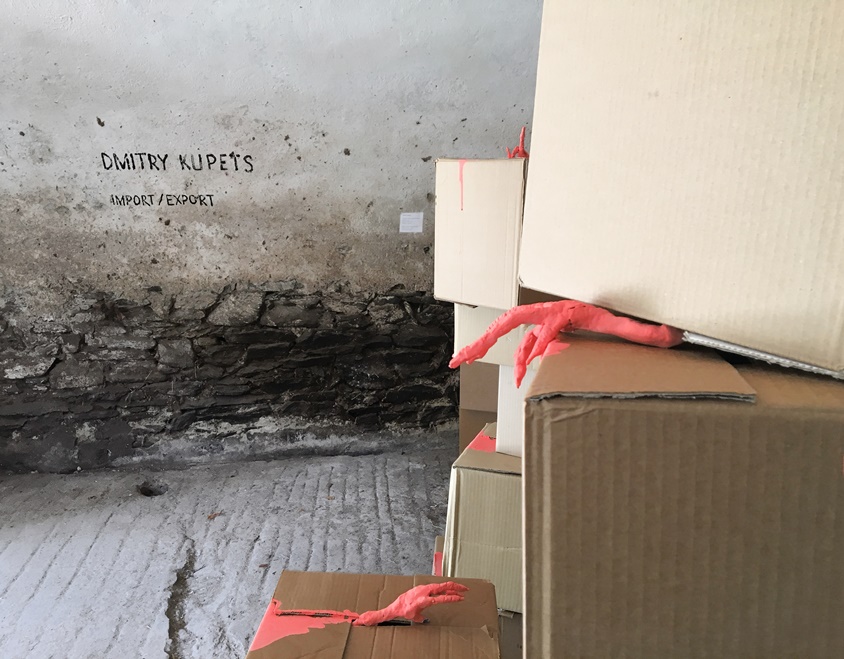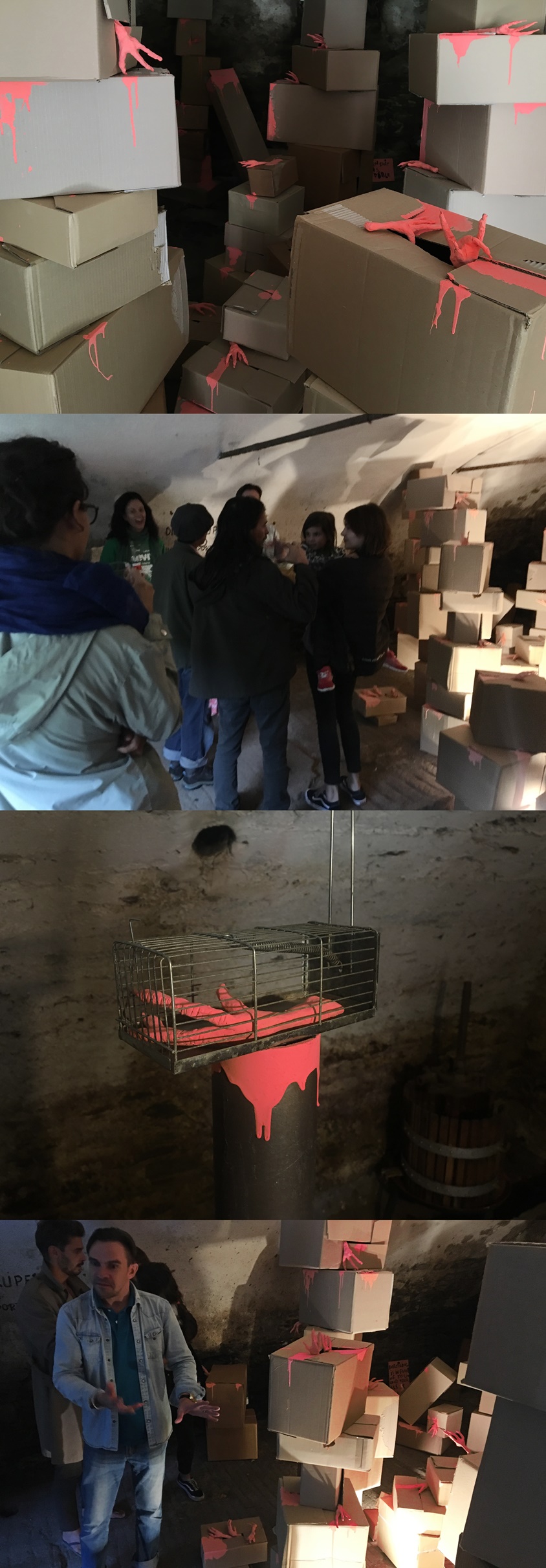
Dmitry Kupets, Import/Export
Import/Export is a portrait of the livelihood of Dmitry Kupets as a merchant. The objects used in the work are actual commercial goods which the artist sells on a daily basis. For example, the artist ships unwanted chicken feet to China where a plateful of ‘Phoenix Talons’ is considered a delicacy. In the West chicken feet are considered a lowly thing (In 2008 the U.S. exported $677 million worth of chicken to China). They scratch in the dirt and shuffle over crowded cage floors. This is of no concern to the merchant. One person’s loss in another person’s gain. And so goes the story of commerce. The story of the modern world.
And in this vast spatial enterprise the figure of the merchant fades to the background as the object of consumption becomes the symbol of commerce. Kupets challenges this aphorism with his self-portrait by undermining the role of the object. The objects on display, whilst being actual representations of the commercial goods themselves, are unmistakably artificial. Through abjured paint strokes and bric-a-brac techniques of construction his artistic effort takes precedence over the realisation of the object itself. In so doing, Kupets portrays himself as an artist-of-a-kind and rejects the literary traditions of depicting merchants as well-presented, honeyed-speaking upstarts.
The portrayal of the merchant Kupets settles upon is depicted as a precarious construction of miscellaneous cultural objects, as he makes an ironic point about identity itself in a capitalist society. This is reinforced by the deceit in choosing to close off the inside of the boxes and the use of a closed cage. The merchant no longer should be imagined as base insofar as they are constructed by the capitalist machine that found its home in cultural spaces. The exhibition of deceit means that it must be shared as opposed to being owned.

- welcome
- program
- 2023
- Gianni Denitto. Live saxophone and electronic
- Monica Perosino. La Neve di Mariupol. Book presentation
- East. Photographs by Alessandro Treggiari
- Katya Kabalina. Sensible objects
- Balovin and Beccato. In Kind Exchange
- Zoya Pilipenko. Puzzles. Open studio
- Lev Nikitin. Senso di Fame. Interactive performance
- Witness Trauma. Film screening and meeting with director Taya Zubova
- Transmorphing. Balovin&Beccato
- Religious/Political. Group exhibition of artists in residency
- 2022
- Ceramographics . Dragoljub David Stankovikj
- Conversation on the war in Ukraine and testimonies of resistance
- Kharkiv 2022. Kirill Gonchar. Photo chronicle of destroyed city
- Meeting with eyewitnesses of the war in Ukraine
- Matteo Tambussi. Concert supporting Ukraine
- Pisa: Ukraine and Russia. Art for Freedom.
- Open Studios. Italian, Ukrainian and Russian artists
- Lorenzo Gnata: Sulla Rotta
- Cristina Arnone: Conversations with trees, animals and human hart
- Gianni Pavan: Sounds and Silence of the Nature
- Daniil Shumikhin. Twenty Twenty Two
- Blu Polokkio
- 2021
- 2020
- Tarik Hanif. Florilegium
- Malacosa Teatro. Atypical Sung Variations.
- Jolin Lab. Stellaria
- Alessandro Sciaraffa, Daniele Galliano. «Stars and Flowers»
- Weaverbirds Collective. Aurora
- Vanja Vukovic. Exclusive Clouds
- Open studio with young artists: Laura Tolen, Jacqueline Hoefnagels, Molly Johnson, Nell Mitchell.
- Alexey Mironov. Bon Voyage
- La Pushkin
- 2019
- Anastasia Sukhareva-Morozova. Utitled
- Sergei Prokofiev. Place
- Lev Nikitin. Scotoma
- Matteo Tambussi. Live
- Beppe Giampà. Live
- Adrian Geller. I was pretty lucky
- Valdo Morel. Flash
- 20 Strings. Live
- Da ladno. Russian Folk
- Cynthia Fusillo. I Have All I Need
- Marta Zapparoli: Acoustic Sketch Portraits
- Erik Schou. Non Ci Sono Lucciole Senza Buio
- Ilaria Allegri. Live
- RednakS
- Stefano Fiori & Giuliano De Marco. Live Blues
- Animated movies
- Simon Lambrey. Being humans.
- Maximiliano Siñani. Apaccieta n.2
- Marina Skepner. My Shallow Roots
- 2018
- Sonic Picnic
- Die Dschunkel
- Iris Jans. Veranderen. Verschuiven
- The Trivettes Bluegrass Night
- Einar Breistrand Gerrard and Vovka Kozhekin
- Domestico — Selvatico
- Mitya Kharshak: Scaffolded City
- La Città delle Vedove di ClaudIo Celentano
- Jam with Dingo
- Con/Certo Senza Biglietto
- Harry Jones–Martin. Moving Semiotics — Language in The DigitaL Age
- Natalya Zaloznaya. The Model of a Failed Escape
- Bread and Jam
- Julia Belova: Mellow Yellow Swallows Bellow
- Makepop!
- The Cartoons You’ve Never Seen: Ivan Maximov, Leonid Shmellkhov and the others
- Camminare con Nicol Guerra
- Dragoljub David Stankovikj: Molitva
- Da Ladno!
- Vea
- Fabrizio Urbisaglia & Ivan Canello
- 2017
- Dragoljub David Stankovikj
- ManiaXXX
- The Crickets Under the Water
- The Cartoons You've Never Seen
- Import/Export
- Forno Filosofico
- Gingi Statman: Mattoni Matti
- Introduction to Meditation with Gian Luigi Cargnel
- Kombu Project
- Beppe Giampà
- Jam with Josephina Schiller
- Orphic Wind Van
- Con/Certo Senza Biglietto
- Ciento Lindo Party
- In Kind Exchange
- Olga Niconova
- Russian Authors Animation
- 2023
- stone oven house
- art residency
- neighbourhood
- donation
- contacts
- FAQ
- RU
- IT

The precarity of each construction not only points to the Kupets’ own habit in courting danger from authorities it also signifies the instability of consumption itself. This is reinforced by the alienating presentation of the cultural objects. Whilst in reality the chicken feet and beer are consumed, their representations are useless. The works ironically inhere a role-reversal whereby the merchant earns his place on his high horse as he moralises about the consumer's role in consumption and about what is important. In so doing the merchant carves out a new space for himself to be portrayed viz. the void between the real and artificial, the meaningful and the meaningless.
But as with all paradoxes they leave a trace of their inconsistency and Kupets does so in the object Stem Cell for here the artist addresses his own experience in trying to broker a development in stem cell research for a renewable source of replacement cells. As capitalism comes to the realisation of its own falsity, the merchant must find other modes of exchange. And so, he spoke his reasons solemnly.